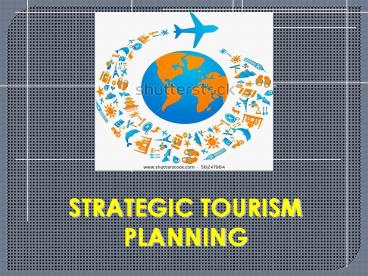Corporate Strategic Planning - PowerPoint PPT Presentation
Title:
Corporate Strategic Planning
Description:
STRATEGIC TOURISM PLANNING Products and services Attributes Features Benefits Values Satisfying needs and wants An business organization exists to accomplish value ... – PowerPoint PPT presentation
Number of Views:211
Avg rating:3.0/5.0
Title: Corporate Strategic Planning
1
STRATEGIC TOURISM PLANNING
2
- An business organization exists
- to accomplish value creation for target
customers
- Products and services
- Attributes
- Features
- Benefits
- Values
- Satisfying needs and wants
Discovery Development Delivery
2/21
3
2. Scanning and analysis
- An organization operates in different
environment, namely politics, economics,
socio-culture, technology and competition
(C-PEST) - There are strengths and weaknesses in the
company, and opportunities and threats in the
companys external environment. (SWOT)
3/21
4
Answer to the environments
- learning
- Adapting
- Influencing
- Manipulating
- Leveraging
- Restructuring
- TOWS Metric
4/21
5
Important Trends
- Political shift
- Economic blocks
- Economic development
- Social changesVALS (Values and life styles),
preferences, tastes, beliefs, perceptions, and
attitudes - Technological development
- Demographic shift
- Natural and ecological changes
- Sustainability planning
- Globalization
5/21
6
Trends
- A marketing plan will be more successful if it is
in line with strong trends, rather than opposed
to them. - Companies must monitor demographic, economic,
natural, technological, political/legal and
social/cultural forces. - Modern consumers will pay more for green
products. - Internationalization is imperative
- Marketers must be aware of diversity of different
generation cohorts. - Increasing alliances and partnerships.
6/21
7
Trends
- Major technological advances.
- Rise of the Pacific Rim
- Rise of modern trade
- Rising e-commerce.
- Increasing importance of speed and convenience
- Mens and womens roles shift.
- Collaboration and co-creation between sellers and
buyers as well as among buyers through various
digital platforms.
7/21
8
Trends
- - Medical and health issues are changing.
- Power of computers and microprocessors increasing
exponentially. - Branding becoming more important.
- Increased use of credit cards and increasing
consumer debt. - Global growth of e-commerce/Internet users
8/21
9
3. Management must define its mission and vision
- What is our business?
- Who is our customer?
- What is value to our customers?
- What should our business be?
- Why do we exist?
- Where and what you want to be in
9/21
10
4. Core Competencies
- Four distinct features
- 1. Knowledge
- (what you know and learned)
- 2. Experience
- (what youve been through
- 3. Resources
- (what you have)
- 4. People
- (what you do and how you do it)
10/21
11
5. Strategic elements
- What market do to want to get in?
- How do you segment your market?
- What segment is your target market?
- What is the profile of your target market?
- What offering do your have for that market?
- What is the positioning of your
product/service? - What is your generic competitive strategy?
- What are your marketing mixes?
- Remarks all of these strategic elements must be
- cohesive with your mission, vision, policy, and
core - competency.
11/21
12
6. PHILOSOPHY OF KILLING STRATEGY
- Embrace innovation.
- Make every product better than its ever been
done before. - Manage both hard factors and soft factors.
- Operate with a sense of excellence.
- Give the same attention to the smallest detail
as you do to the largest. - Sustain your competitive advantages.
12/21
13
7. A vision statement should describe
- Whats happening to the company and its
competition - What the company wants to do about it to achieve
its mission. - And should guide decision-making for the future
growth.
13/21
14
8. Typical Ideal Vision
A. Product leadership
- Innovation for cost-efficient focused
diversified - high quality
- Best service in town
D. Globalization with world class standard
E. Provide total solution to better human life
and sustain ecological environment
14/21
15
- 9. The companys specific mission or purpose is
usually clear when the company is founded.
- Over time the mission may change due to
- changing market conditions
- Or the corporation makes changes by
- adding new products and services
15/21
16
10. Marketing Mixes
- Product
- Price
- Place
- Promotion
- Packaging
- Public relations
- People
- Process
- Planning policy
- particularity
- Power
- Population
- program
- Partnership
- Permission
- Positioning
- Package
- Payment
- Physical environments
- Purple cow
16/21
17
11. IMC Plan
- Advertising
- Public Relations
- Events
- Sales promotion
- Direct marketing
- Interactive
- Demonstration center
- Show room
- Merchandising
- Display and P.O. P
- Publications
- Services
- CRM
- CEM
- Call center
- Brand ambassadors
17/21
18
12. Elements of Marketing Plan
- Executive summary
- Table of Contents
- Situation Analysis
- (C-PEST)
- SWOT Analysis
- TOWS matrix
- Objectives
- Assumptions
- Strategic statement
- Segmentation
- Targets
- Positioning
- Generic strategy
- Tactical decisions on marketing mixes
- Budgeting
- Action plan
18/21
19
13. Innovative Marketing
- Brand Marketing
- Content marketing
- Experiential marketing
- Relationship marketing
- Digital marketing
- Image marketing
- Retrospective marketing
- Blue ocean marketing
- White ocean marketing (Marketing 3.0)
- Low cost marketing
- Precision marketing
- Retrospective marketing
19/21
20
- 14. Successful companies raise these questions
constantly. The answers are shaped by
- Has the mission be achieved?
- Is the company is market-driven?
- How well the company respond to
- the environment?
- How well does the company leverage
- resources and its distinctive competency?
- Does it has superior and relevant value
- for the target market?
- - Is it good at both offensive and defensive
marketing?
20/21
21
END































